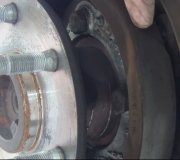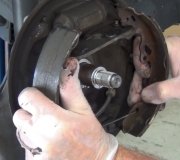If you have anti-lock brakes, the scanner is needed to open two valves only if air made it down that far. If the reservoir never ran empty during other services, there won't be air in those chambers. Most commonly this happens when do-it-yourselfers take too long to replace calipers. All the while they're off, fluid is draining from the hoses. A simple trick to avoid that is to place stick between the seat and brake pedal to hold the pedal down about two inches. Gravity will not be strong enough to pull brake fluid past the lip seals.
This might not work well on Fords that have four steel lines leaving the master cylinder, but you can still try it. For vehicles with two lines, loosen the soft metal line nuts a little, then unbolt the master cylinder from the power booster. Use it as a handle to bend the lines upward a little. That will prevent fluid from running out of those lines. Unbolt the lines and remove the master cylinder. Careful to not dribble brake fluid on the paint as it will eat it.
Screw the lines onto the new, bench-bled master cylinder, and just snug them. Bend the lines back down so the master cylinder can be easily slid onto the studs on the booster, and tighten the nuts. Now loosen one line about 1/4 turn and have a helper slowly push the brake pedal halfway to the floor. It's important that they tell you when it's there, and they hold it there. Tighten the nut, THEN tell them to release the pedal quickly. Loosen the nut again, then have the helper slowly push the pedal again. It should take them about 20 seconds to get half way to the floor. That pushes brake fluid down the line and gives any air bubbles time to float back up. Releasing the pedal quickly washes any stuck air bubbles into the reservoir along with the brake fluid rushing back. If the helper releases the pedal before you have the nut tight, air will be sucked back in and make the job take longer or be ineffective.
I've replaced dozens of master cylinders using this trick and never needed to bleed at the wheels. If the master cylinder is less than about a year old, it will not be damaged by pushing the brake pedal all the way to the floor, but that is a habit you want to avoid. When they get older, crud and corrosion builds up in the lower halves of the bores where the pistons don't normally travel. Pushing the pedal to the floor, whether bleeding improperly, or when surprised by a sudden leak, runs the rubber lip seals over that crud and can rip them. That usually results in a slowly-sinking brake pedal, or in no pressure at all, and that often doesn't show up for two or three days. A lot of shops automatically include a rebuilt master cylinder in their repair estimates when a car comes in with a leak, and it's likely the owner pushed the pedal to the floor. It's safer and less frustrating than explaining to the customer that more parts are needed than were first expected.
Monday, January 15th, 2018 AT 6:39 PM


